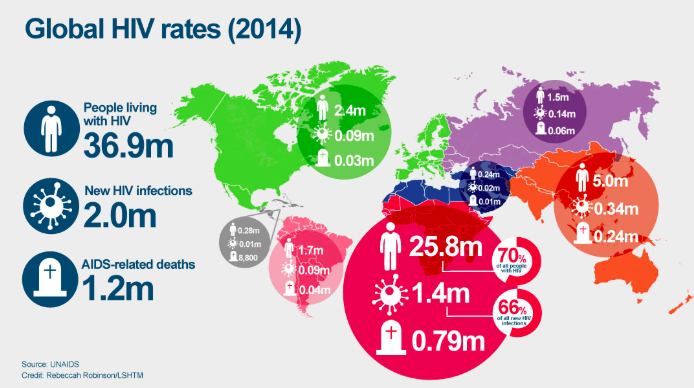D.5 Antiviral medications
Written specifically for students to provide help and support for the IB Diploma chemistry programme this page provides full coverage of the syllabus content of Option D - sub topic D.5. It encourages you to think critically and provides many questions with full worked answers so that you can monitor and improve your knowledge and understanding.


 Learning outcomes
Learning outcomes
 After studying this topic you should be able to:
After studying this topic you should be able to:
Understand
- Viruses are more difficult to treat with drugs than bacteria as they lack a cellular structure.
- Antiviral drugs may function by altering genetic material within a cell to prevent the virus from using it to multiply. Alternatively they may block enzyme activity within the host cell, which also prevent the viruses from multiplying.
Apply your knowledge to:
- Explain the different ways in which antiviral medications function.
- Describe how viruses differ from bacteria.
- Explain how oseltamivir (Tamiflu) and zanamivir (Relenza) function as preventative agents against flu viruses.
- Compare the structures of oseltamivir and zanamivir.
- Discuss the difficulties associated with solving the AIDS problem.
Relationships & vocabulary
Nature of science
Collaboration between researchers in the scientific community has improved our understanding of how viruses interact with host cells to cause disease.International-mindedness
The AIDS epidemic is a global disease which has had a huge impact upon society and life expectancy. How has it changed since its discovery in the early 1980s and how can the spread of the disease be halted?Vocabulary
| capsid | capsomer | human immunodeficiency virus | T-helper cell |
| acyclovir | amantadine | acquired immune deficiency syndrome (AIDS) | AZT |
Learning slides
You can use this slide gallery for learning or for reviewing concepts and information. It covers all the key points in the syllabus for this sub-topic.
Something to think about
The effective treatment of viral diseases is fraught with problems. Viruses multiply rapidly so by the time the disease is identified the number of viruses in the body is huge and viruses regularly mutate so may develop ways of combating antiviral drugs. It is much more effective to prevent viral infections from breaking out in the first place through active immunisation programmes and by taking preventative methods (e.g. the use of condoms to prevent HIV transmission) to stop the spread of the disease.
The two main ways in which current antiviral medications work is either by altering genetic material within the host cell, which prevents the virus from multiplying, or by blocking the active site on enzymes within the host cell, which prevents the virus from leaving the cell. A good example for the first method is the use of acyclovir and ganciclovir against herpes infections. These have structures similar to deoxyguanosine so they ‘trick’ the viral enzymes into using it as a building block for the viral DNA.
.png)
Other antiviral medications that work by altering genetic material in the host cell are amantadine and rimantadine used in the past to treat influenza and the common cold. They are now almost 100% ineffective as viruses have developed resistance to them.
The syllabus lists oseltamivir (Tamiflu) and zanamivir (Relenza), used to treat influenza, as examples of antiviral medications that work by blocking the active site of enzymes. A comparison of their structures shows that oseltamivir is an ester and is less polar than zanamivir, which contains a carboxyl group, several hydroxyl groups and more amine groups than oseltamivir. In fact oseltamivir itself is inactive. It is a good example of a drug to use to explain the concept of ‘active metabolite’ as once it gets to the liver it is metabolized to its active form, oseltamivir carboxylate. Students can see that this is an example of ester hydrolysis as the ester group on the oseltamivir is hydrolysed to the carboxyl group with the release of methanol. These drugs work by acting as competitive inhibitors on the neuraminidase enzymes, which prevent the viruses from escaping from the host cell. It is worth pointing out that there is considerable controversy about the use and effectiveness of these two drugs, particularly oseltamivir. It is another example of where the profits of the pharmaceutical companies compete with the impartial gathering and reporting of clinical data.
Test your understanding of this topic
(Note that your teacher may have restricted your access to some or all of these questions and worked answers if they are going to use them as a class test or set them as an assignment.)
For ten 'quiz' questions (for quick testing of knowledge and understanding with the answers explained) see MC test: Antiviral medications.
For short-answer questions see Antiviral medications questions together with the worked answers on a separate page Antiviral medications answers.
More resources
1. A powerpoint can be downloaded from the World of Teaching which has some useful images but probably too much detail on how bacteria and viruses ![]() differ. (Note it takes a little time to download)
differ. (Note it takes a little time to download)
2. An interesting video from Australia which questions how effective oseltamivir (tamiflu) is. Good for Nature of Science as well!
3. A useful video to show students is What you need to know about HIV/AIDS by Dr Becky Kuhn. It is more for their personal education on how to avoid catching the virus but does not preach.
4. A really good video rom the Howard Hughes Institute shows how AZT blocks reverse transcriptase ![]() in HIV. Another good video from the RCSB Protein Data Bank (suggested by David Gould from Markham College in Lima, Peru) shows an animated
in HIV. Another good video from the RCSB Protein Data Bank (suggested by David Gould from Markham College in Lima, Peru) shows an animated ![]() molecular view of HIV therapy.
molecular view of HIV therapy.
5. There are many references to HIV/AIDS that can be found on the Internet e.g.

 IB Docs (2) Team
IB Docs (2) Team 












